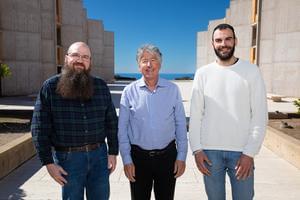An international team of researchers led by the University of Bristol has shed light on Earth’s earliest ecosystem, showing that within a few hundred million years of planetary formation, life on Earth was already flourishing.



In this episode, Ben Watkins sits down with Professor Pete Mandik to discuss several different ways of conceiving of materialism along with strengths and weaknesses of each approach. Professor Mandik also gives a summary of a view inspire by Quine he calls “Type-Q Materialism.” Additionally, Ben and Professor Mandik discuss various aspects of religious mysticism and touch on the philosophy of Ludwig Wittgenstein.
Daniel Dennett is one of the most influential philosophers in the world. He is an atheist, Darwinist and materialist. For him, we humans are nothing but a complex piece of matter subject to natural laws. He talks to Yves Bossart about our consciousness, illusions, freedom and faith.
German version: • Daniel Dennett im Gespräch über Geist…
More of the series: • 🌍 Videos in anderen Sprachen.
SRF Sternstunde Philosophie vom 18.02.
Mehr Kultur auf YouTube.
🔔
Mehr Kultur auf Facebook.
👥 / srfkultur.
Mehr Kultur auf Twitter.
What makes one a person or a self? If he or she sees, hears, thinks and feels, is that a person or a self? How can separate perceptions bind together into a coherent mental unity of a single person or self?
For all of our video interviews please visit us at www.closertotruth.com
King Philosophy is a global organisation dedicated to developing emotional intelligence, both through our YouTube channel and our real-life school located on 10 campuses around the world. We apply psychology, philosophy, and culture to everyday life, addressing the questions we’re never taught enough about at regular school or college: How can relationships go well? What is meaningful work? How can love last? How can one find calm? What has gone wrong (and right) with capitalism? We love the humanities, especially philosophy, psychotherapy, literature and art — always going to them in search of ideas that are thought-provoking, useful and consoling.
We’re about wisdom, emotional intelligence and self-understanding.
Please subscribe us more…
/ @kingphilosophy775

Physicists in Konstanz (Germany) have discovered a way to imprint a previously unseen geometrical form of chirality onto electrons. The electrons are shaped into chiral coils of mass and charge. Such engineered elementary particles may open new research avenues in fundamental physics and electron microscopy.
Have you ever placed the palm of your left hand on the back of your right hand, in such a way that all fingers point in the same direction? If you have, then you probably know that your left thumb will not touch its right counterpart. Neither rotations nor translations nor their combinations can turn a left hand into a right hand and vice versa. This feature is called chirality.
Scientists at the University of Konstanz have now succeeded to imprint such a three-dimensional chirality onto the wave function of a single electron. They used laser light to shape the electron’s matter wave into left-handed or right-handed coils of mass and charge. Such engineered elementary particles with chiral geometries other than their intrinsic spin have implications for fundamental physics but may also be useful for a range of applications, such as quantum optics, particle physics or electron microscopy.
Katie Mack, Perimeter Institute’s Hawking Chair in Cosmology and Science Communication, takes us on journey through time by exploring the cosmic microwave background (CMB), the faint glow from the Big Bang.
The CMB shows us the universe as it was 13.8 billion years ago, revealing secrets about its…
In this episode of Cosmology 101, we journey through time by exploring the cosmic microwave background (CMB), the faint glow from the Big Bang.
The CMB shows us the universe as it was 13.8 billion years ago, revealing secrets about its origins and composition. Discover how this ancient light provides insights into the early universe and helps us understand the cosmos we see today.
Join Katie Mack, Perimeter Institute’s Hawking Chair in Cosmology and Science Communication, on an incredible journey through the cosmos in our new series, Cosmology 101.
Sign up for our newsletter and download exclusive cosmology posters at: https://landing.perimeterinstitute.ca…

Wormholes, a captivating theoretical concept, offer a potential shortcut through space and time—a celestial tunnel connecting distant points through the intricate fabric of space-time. The inception of this idea dates all the way back to 1935 when Albert Einstein and Nathan Rosen proposed the concept of a wormhole, also known as an Einstein-Rosen bridge, as a unique solution within the framework of Einstein’s General Relativity(GR). The hypothetical existence of wormholes carries profound implications for space travel, such as the ability to traverse vast cosmic distances in remarkably short durations, and exploring their properties and implications could provide important information about the structure of space-time itself.
Furthermore, being closely linked to other perplexing cosmic phenomena, such as black holes, dark matter, and the enigmatic event known as the Big Bang—the cosmic genesis that set our universe into motion—wormholes have the potential to provide insights into these cosmic puzzles and deepen our understanding of the origin of the universe. Additionally, investigating wormholes could help bridge the gap between GR and quantum mechanics, which is currently one of the most important problems in theoretical physics.
Inspired by this, a team of researchers, led by Dr. P.K. Sahoo in collaboration with Mr. Zinnat Hassan from the Department of Mathematics at the Hyderabad Campus of Birla Institute of Technology (BITS) Pilani, recently delved into the investigation of wormholes. They focused on the modified teleparallel gravity framework with conformal symmetry within the context of non-commutative geometry. The primary objective of their research was to shed light on the specific conditions required for the existence of wormholes within the above framework. “The study of wormholes within the context of f(Q) symmetric teleparallel gravity with conformal symmetry under non-commutative geometry represents a sophisticated and specialized area of research in the field of theoretical physics and cosmology,” says Dr. Sahoo. Their findings were published in volume 437 of the journal Annals of Physics in February 2022.

LA JOLLA (March 4, 2024)—Charles Darwin described evolution as “descent with modification.” Genetic information in the form of DNA sequences is copied and passed down from one generation to the next. But this process must also be somewhat flexible, allowing slight variations of genes to arise over time and introduce new traits into the population.
But how did all of this begin? In the origins of life, long before cells and proteins and DNA, could a similar sort of evolution have taken place on a simpler scale? Scientists in the 1960s, including Salk Fellow Leslie Orgel, proposed that life began with the “RNA World,” a hypothetical era in which small, stringy RNA molecules ruled the early Earth and established the dynamics of Darwinian evolution.
New research at the Salk Institute now provides fresh insights on the origins of life, presenting compelling evidence supporting the RNA World hypothesis. The study, published in Proceedings of the National Academy of Sciences (PNAS) on March 4, 2024, unveils an RNA enzyme that can make accurate copies of other functional RNA strands, while also allowing new variants of the molecule to emerge over time. These remarkable capabilities suggest the earliest forms of evolution may have occurred on a molecular scale in RNA.